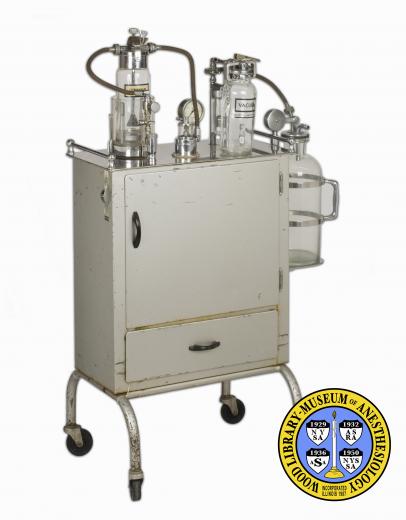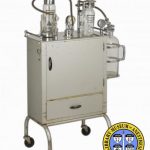Herb-Mueller Apparatus
Designed by Dr. Isabella C. Herb (1863-1943) and manufactured by V. Mueller & Co. of Chicago, the Herb-Mueller Ether Vapor and Vacuum Apparatus was introduced around 1933. This machine provided two important functions: a means to administer ether, as well as a way to suction blood and mucous from the surgical area and the patient’s airway. It was especially popular with dentists and ear, nose and throat surgeons.
After the death of her husband, Dr. Herb attended Northwestern University Women’s Medical School while in her mid-20s. She proceeded to build an impressive career during a time when female physicians faced a great deal of prejudice and discrimination. In 1899 she became the first "physician anesthetist" at the Rochester, Minnesota Mayo Clinic. In 1909 Dr. Herb was appointed chief anesthetist at Chicago’s Presbyterian Hospital and Rush Medical College. Herb was active in many professional organizations, and authored numerous scholarly articles as well as a chapter on general anesthesia in the popular textbook Oxford Loose-Leaf Surgery. The ether and vacuum machine and an anesthetic screen are just two of her contributions to anesthetic equipment design.
Catalog Record: Herb-Mueller Apparatus
Access Key: aiwt
Accession No.: 2004-01-26-1 A
Title: Ether vapor-vacuum apparatus / [designed by Isabella Herb].
Author: Herb, Isabella C. (Coler), 1863-1943.
Corporate Author: V. Mueller & Co.
Title variation: Alt Title
Title: Herb-Mueller ether vapor and vacuum apparatus.
Title variation: Alt Title
Title: Suction-ether unit.
Publisher: Chicago : V. Mueller & Co., [1937-1950].
Physical Description: 1 anesthesia machine : steel, stainless steel, nickel plated brass, other metals, glass, rubber, paint ; 124 x 77 x 48 cm.
Subject: Anesthesia Machines.
Subject: Ether, Ethyl.
Subject: Herb, Isabella C. (Coler), 1863?-1943.
Note Type: General
Notes: Title from markings on apparatus. Alternate title from instruction manual
with apparatus.
Note Type: General
Notes: Early date in the date range for the possible year of manufacture is based on
information from DuPont’s “Heritage” webpages. They report that DuPont
switched to the generic name “neoprene” from the trade name “DuPrene” in 1937
Late date based on a note handwritten on the instruction manual that is with
the apparatus: “Delivered [Delivered] Oct 12, 1950”.
Note Type: Citation
Notes: Braun WC. The technical exposition. JAMA. May 13, 1933;100(19):1536-1539.
Note Type: Citation
Notes: Strickland RA. Isabella Coler Herb, MD: an early leader in anesthesiology.
Anesth Analg. 1995;80(3):600-605.
Note Type: Physical Description
Notes: One ether and suction anesthesia machine; The body of the machine is a
cabinet on four legs with wheels; This description is based on the
perspective of a user facing the front of the machine, i.e. “left” is the
user’s left, “right” is the user’s right; The exterior of the cabinet
measures approx. 61 x 53 x 26 cm; The cabinet’s large front door opens to a
spacious compartment that holds the motor that powers the vacuum for the
suction; Held inside a frame on the inside of the cabinet door is a manual
titled, “Instructions for Operating THE HERB-MUELLER ETHER VAPOR AND VACUUM
APPARATUS”; Most of the other components sit on top of and to the right side
of the cabinet; A small storage drawer is located below the front door and
motor compartment; On the cabinet top an ether bottle sits on the left side;
The ether bottle is labeled in large letters, “ETHER”; In approx. the center
of the cabinet top is a vacuum gauge numbered from 0 to 30 and marked with,
“VACUUM”, the U.S. Gauge Co. logo, and “MADE IN U.S.A. 2 1/2 AD-6695”; In
front of the vacuum gauge, a plate attached to the cabinet top is marked,
“Ether Vapor-Vacuum Apparatus [new line] MODEL H, SERIAL NO. 284, VOLTS 115,
AMPS 32, CYCLES 60 [new line] MADE BY V. MUELLER & CO., CHICAGO [new line]
-CAUTION- [new line] SEE THAT BOTTLE SUPPORT IN RESERVOIR IS COVERED WITH
WATER. DO NOT FILL WITH ETHER WHEN MOTOR IS RUNNING. DO NOT SPILL ETHER. SEE
THAT ELECTRICAL CONNECTIONS ARE SOUND.”; A glass vacuum bottle marked in
large letters, “VACUUM” sit on the right side of the cabinet top; Marked in
smaller lettering below “VACUUM” is “DO NOT FILL ABOVE THIS LINE”; On the
right side of the cabinet is a thin, rounded, metal shelf that extends out
approx. 18 cm; On top of the shelf, on the right side of the cabinet is a
large glass bottle, or jug, with a metal handle; The jug measures approx. 37
cm in height, with a dia. of approx. 15 cm at the base and 7 cm at the neck;
On the upper right side of the cabinet is a switch labeled, “MOTOR”; On the
upper left side of the cabinet is a switch labeled, “HEATER”; An electrical
cord extends from the center of the back of the cabinet; The cord is covered
in black neoprene, and is marked with, “Simplex-Tirex Neoprene Armor P
101-BM”; The end of the electrical cord ends in a 3 pronged plug.
Note Type: Reproduction
Notes: Photographed by Mr. William Lyle, July 28, 2010.
Note Type: Acquisition
Notes: Donated to the WLM by Parkland Health and Hospital System, Texas. Facilitated
by Ron Anderson, M.D. and Adolph Giesecke, M.D.
Note Type: Historical
Notes: Possibly introduced in 1933 the Herb-Mueller Ether Vapor and Vacuum Apparatus
provided two important functions: The means to administer ether as well as a
way to clear blood and mucous from the surgical area and the patient’s airway
It was especially popular with dentists and ear, nose and throat surgeons. A
later model was designed to prevent fires and explosions caused by electric
sparks igniting ether vapor. It was appropriately called the “Herb-Mueller
Explosion Proof Ether Vapor and Vacuum Unit.”. The 1933 date is based on an
announcement of an upcoming V. Mueller exhibit printed in a 1933 issue of
JAMA: “V. Mueller & Co. will exhibit their usual … . Ask for complete
details on the new Herb-Mueller Ether Vapor and Vacuum Apparatus. …” (Braun
1933).
Note Type: Historical
Notes: Although a good deal of evidence of Dr. Isabella Herb’s professional career
exists, very little is known of her personal life. She was born in 1863 and died in 1943.
After the death of her husband, Dr. Herb attended Northwestern University Women’s Medical
School while in her mid-20s. She proceeded to develop an impressive career during a time
when female physicians faced a great deal of prejudice and discrimination. Her many
achievements include becoming the first “physician anesthetist” at the
Rochester, Minnesota Mayo Clinic in 1899. In 1909 Herb was appointed chief
anesthetist at Presbyterian Hospital and Rush Medical College. Herb was
active in many professional organizations, and authored numerous scholarly
articles as well as a chapter on general anesthesia in the popular Oxford
Loose-Leaf Surgery. The ether and suction apparatus and an anesthetic screen
are just two of her contributions to anesthetic equipment design.


